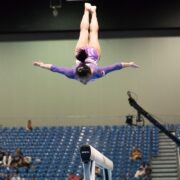
Maximize Power: Plyometric Exercises for Explosive Moves
Plyometric exercises, also known as jump training or plyos, are a form of training that focuses on explosive movements to develop power and improve athletic performance. These exercises involve rapid stretching and contracting of muscles, which helps to increase the efficiency of the neuromuscular system and develop fast-twitch muscle fibers. Explosive power is crucial in sports and fitness activities as it allows athletes to generate maximum force in a short amount of time, leading to improved speed, agility, and overall performance.
The concept of plyometric training can be traced back to the 1960s when Soviet athletes began incorporating these exercises into their training routines. The term “plyometrics” was coined by American coach Fred Wilt in the 1970s, and since then, plyometric training has gained popularity among athletes and fitness enthusiasts worldwide. Today, plyometrics are widely used in various sports, including basketball, soccer, track and field, and martial arts, as well as in general fitness programs.
Key Takeaways
- Plyometric exercises are designed to improve explosive power in athletes.
- Plyometrics involve rapid stretching and contracting of muscles to increase power output.
- Benefits of plyometric exercises include improved athletic performance, increased strength, and reduced risk of injury.
- Lower body plyometric exercises include jump squats, box jumps, and single-leg hops.
- Upper body plyometric exercises include medicine ball throws, clap push-ups, and plyometric pull-ups.
Understanding the Science of Plyometrics
To understand how plyometric exercises work, it’s important to grasp the concept of the stretch-shortening cycle. This cycle involves three phases: the eccentric phase (muscle lengthening), the amortization phase (transition phase), and the concentric phase (muscle shortening). During the eccentric phase, the muscles are stretched rapidly, storing elastic energy. In the amortization phase, there is a brief pause before the muscles contract concentrically to produce explosive power.
Plyometrics improve neuromuscular efficiency by enhancing the communication between the nervous system and muscles. The rapid stretching and contracting of muscles during plyometric exercises help to activate more motor units and recruit more muscle fibers. This increased recruitment leads to improved coordination and synchronization of muscle contractions, resulting in greater power output.
Furthermore, plyometrics play a significant role in developing fast-twitch muscle fibers. These muscle fibers are responsible for generating quick and powerful movements. By engaging in plyometric exercises, athletes can stimulate the growth and activation of these fast-twitch muscle fibers, leading to enhanced explosive power and athletic performance.
Benefits of Plyometric Exercises for Athletic Performance
Plyometric exercises offer a wide range of benefits for athletic performance. Here are some of the key advantages:
1. Increased power and explosiveness: Plyometrics are specifically designed to improve explosive power, allowing athletes to generate maximum force in a short amount of time. This increased power translates into improved performance in sports that require quick and explosive movements, such as sprinting, jumping, and throwing.
2. Improved speed and agility: Plyometric training helps to enhance speed and agility by improving the efficiency of muscle contractions and increasing the rate of force development. This allows athletes to accelerate faster, change direction quickly, and react more explosively to game situations.
3. Enhanced endurance and stamina: While plyometrics primarily focus on explosive movements, they also contribute to overall endurance and stamina. The high-intensity nature of plyometric exercises helps to improve cardiovascular fitness and muscular endurance, enabling athletes to perform at a high level for longer periods.
4. Reduced risk of injury: Plyometric training can help to strengthen muscles, tendons, and ligaments, reducing the risk of injuries such as sprains and strains. Additionally, plyometrics improve proprioception (the body’s awareness of its position in space), which can help athletes maintain balance and stability during dynamic movements, further reducing the risk of injury.
Plyometric Exercises for Lower Body Explosiveness
| Exercise | Description | Muscles Worked | Repetitions | Sets | Rest Time |
|---|---|---|---|---|---|
| Box Jumps | Jumping onto a box or platform from a standing position | Quadriceps, Glutes, Hamstrings, Calves | 8-12 | 3-4 | 1-2 minutes |
| Depth Jumps | Jumping off a box or platform and immediately jumping as high as possible upon landing | Quadriceps, Glutes, Hamstrings, Calves | 6-8 | 3-4 | 2-3 minutes |
| Lateral Bounds | Jumping laterally from one foot to the other | Quadriceps, Glutes, Hamstrings, Calves | 10-12 | 3-4 | 1-2 minutes |
| Squat Jumps | Jumping as high as possible from a squatting position | Quadriceps, Glutes, Hamstrings, Calves | 8-10 | 3-4 | 1-2 minutes |
| Tuck Jumps | Jumping as high as possible while bringing the knees up to the chest | Quadriceps, Glutes, Hamstrings, Calves | 10-12 | 3-4 | 1-2 minutes |
Plyometric exercises for the lower body focus on developing explosive power in the legs and hips. Here are some effective exercises:
1. Squat jumps: Start in a squat position with your feet shoulder-width apart. Explosively jump up as high as you can, extending your hips and knees. Land softly back into the squat position and repeat.
2. Box jumps: Stand in front of a sturdy box or platform. Jump onto the box, landing with both feet simultaneously. Step down and repeat.
3. Lateral bounds: Start in a semi-squat position with your feet hip-width apart. Jump laterally to the right, landing on your right foot. Immediately jump laterally to the left, landing on your left foot. Continue alternating sides.
4. Single-leg hops: Stand on one leg with a slight bend in the knee. Hop forward as far as you can, landing softly on the same leg. Repeat for the desired number of repetitions before switching to the other leg.
Plyometric Exercises for Upper Body Power
Plyometric exercises for the upper body focus on developing explosive power in the arms, shoulders, and chest. Here are some effective exercises:
1. Medicine ball throws: Stand with your feet shoulder-width apart, holding a medicine ball at chest level. Explosively throw the ball forward as far as you can, using your entire body to generate power. Catch the ball and repeat.
2. Plyometric push-ups: Start in a push-up position with your hands slightly wider than shoulder-width apart. Lower your chest towards the ground, then explosively push up with enough force to lift your hands off the ground. Land softly and repeat.
3. Clap push-ups: Similar to plyometric push-ups, but instead of lifting your hands off the ground, clap your hands together in mid-air before landing softly and repeating.
4. Overhead throws: Stand with your feet shoulder-width apart, holding a medicine ball overhead. Explosively throw the ball straight up into the air as high as you can, using your entire body to generate power. Catch the ball and repeat.
Plyometric Exercises for Core Strength and Stability
Plyometric exercises for the core focus on developing explosive power in the abdominal and lower back muscles. Here are some effective exercises:
1. Plank jumps: Start in a plank position with your forearms on the ground and your body in a straight line. Jump both feet forward towards your hands, then jump them back to the starting position. Repeat for the desired number of repetitions.
2. Medicine ball slams: Stand with your feet shoulder-width apart, holding a medicine ball overhead. Explosively slam the ball down to the ground in front of you, using your core muscles to generate power. Catch the ball and repeat.
3. Russian twists: Sit on the ground with your knees bent and your feet off the floor, holding a medicine ball in front of your chest. Twist your torso to the right, touching the ball to the ground beside you. Twist to the left, touching the ball to the ground on the other side. Continue alternating sides.
4. Standing long jumps: Start with your feet shoulder-width apart. Squat down and explosively jump forward as far as you can, swinging your arms for momentum. Land softly and repeat.
Plyometric Exercises for Speed and Agility
Plyometric exercises for speed and agility focus on developing quickness and agility in movements. Here are some effective exercises:
1. High knees: Stand with your feet hip-width apart. Run in place, lifting your knees as high as possible while pumping your arms at a fast pace.
2. Skater jumps: Start with your feet together, then jump laterally to the right, landing on your right foot with your left foot behind you. Immediately jump laterally to the left, landing on your left foot with your right foot behind you. Continue alternating sides.
3. Agility ladder drills: Set up an agility ladder on the ground and perform various drills, such as high knees, lateral shuffles, and quick feet drills.
4. Cone hops: Set up a series of cones in a straight line, about one foot apart. Hop over each cone laterally, landing softly and immediately hopping over the next cone. Repeat for the desired number of repetitions.
Plyometric Exercises for Endurance and Stamina
Plyometric exercises for endurance and stamina focus on developing cardiovascular fitness and muscular endurance. Here are some effective exercises:
1. Burpees: Start in a standing position, then squat down and place your hands on the ground in front of you. Kick your feet back into a push-up position, then quickly bring them back in towards your hands. Explosively jump up as high as you can, reaching your arms overhead. Land softly and repeat.
2. Jumping jacks: Start with your feet together and your arms by your sides. Jump both feet out to the sides while simultaneously raising your arms overhead. Jump back to the starting position and repeat.
3. Mountain climbers: Start in a push-up position with your hands directly under your shoulders. Bring one knee towards your chest, then quickly switch legs, alternating back and forth as fast as possible.
4. Tuck jumps: Start with your feet shoulder-width apart. Squat down and explosively jump up, bringing your knees towards your chest in mid-air. Land softly and repeat.
Common Mistakes to Avoid When Doing Plyometric Exercises
While plyometric exercises can be highly effective, it’s important to avoid common mistakes that can lead to injury or hinder progress. Here are some mistakes to avoid:
1. Not warming up properly: Plyometric exercises are high-intensity and put a significant amount of stress on the muscles and joints. Failing to warm up properly can increase the risk of injury. Always start with a dynamic warm-up that includes movements that mimic the exercises you’ll be performing.
2. Using improper form: Proper form is crucial when performing plyometric exercises to ensure maximum effectiveness and reduce the risk of injury. Focus on maintaining good posture, engaging the core, and landing softly to absorb the impact.
3. Doing too much, too soon: Plyometric exercises are demanding on the body, and it’s important to gradually increase intensity and volume over time. Doing too much, too soon can lead to overtraining, fatigue, and increased risk of injury. Start with lower-intensity exercises and gradually progress as your strength and conditioning improve.
4. Neglecting rest and recovery: Plyometric exercises place a significant amount of stress on the muscles and require adequate rest and recovery to allow for adaptation and growth. Failing to incorporate rest days into your training program can lead to overuse injuries and hinder progress. Listen to your body and give yourself time to recover between plyometric workouts.
Plyometric Training Tips and Techniques for Maximal Power Output
To maximize the benefits of plyometric training and achieve optimal power output, consider the following tips and techniques:
1. Gradually increase intensity and volume: Start with lower-intensity exercises and gradually increase the intensity and volume over time. This allows your body to adapt to the demands of plyometrics and reduces the risk of injury.
2. Incorporate plyometrics into a well-rounded training program: Plyometric exercises should be incorporated into a well-rounded training program that includes strength training, cardiovascular exercise, flexibility training, and rest days. This ensures balanced development and reduces the risk of overuse injuries.
3. Focus on quality over quantity: Plyometric exercises are most effective when performed with proper form and maximum effort. Focus on quality repetitions rather than trying to complete a certain number of repetitions in a given time frame.
4. Listen to your body and adjust as needed: Pay attention to how your body feels during plyometric workouts. If you experience pain or discomfort, it’s important to modify or stop the exercise to prevent injury. Additionally, adjust the intensity and volume of your workouts based on your individual fitness level and goals.
Plyometric exercises are a valuable tool for developing explosive power, speed, agility, endurance, and overall athletic performance. By incorporating plyometrics into your training routine, you can enhance your performance in sports and fitness activities while reducing the risk of injury. Whether you’re an athlete looking to improve your game or a fitness enthusiast seeking to take your workouts to the next level, plyometric exercises offer a wide range of benefits. So why not give them a try and experience the power of plyometrics for yourself?
FAQs
What are plyometric exercises?
Plyometric exercises are explosive movements that involve jumping, hopping, and bounding. These exercises are designed to improve power, speed, and agility.
What are the benefits of plyometric exercises?
Plyometric exercises can improve athletic performance by increasing power, speed, and agility. They can also improve bone density, reduce the risk of injury, and improve overall fitness.
Who can benefit from plyometric exercises?
Plyometric exercises can benefit athletes of all levels, as well as anyone looking to improve their overall fitness. However, they should be performed with caution and under the guidance of a qualified trainer.
What are some examples of plyometric exercises?
Examples of plyometric exercises include box jumps, jump squats, burpees, and plyometric push-ups. These exercises can be modified to suit different fitness levels and goals.
How often should plyometric exercises be performed?
Plyometric exercises should be performed no more than two to three times per week, with at least 48 hours of rest between sessions. They should also be incorporated into a well-rounded fitness program that includes strength training, cardiovascular exercise, and flexibility training.
Are plyometric exercises safe?
Plyometric exercises can be safe when performed correctly and under the guidance of a qualified trainer. However, they can also be high-impact and put stress on the joints, so it is important to start slowly and progress gradually. Individuals with a history of joint problems or injuries should consult with a healthcare professional before starting a plyometric exercise program.


















